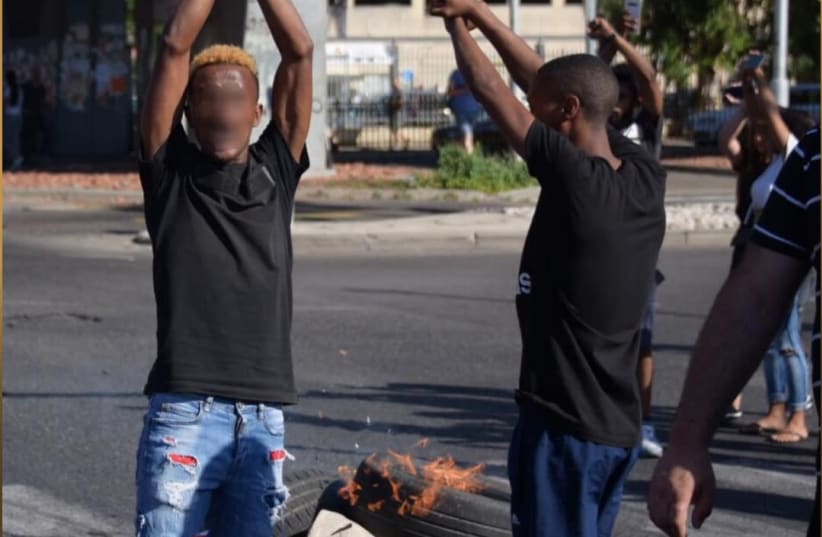Over the last few days, public discourse in Israel has been dominated by the question of responsibility: the responsibility of the state for the welfare and current situation of the Ethiopian community, the responsibility of the police for the killing of Ethiopian-Israeli youth Solomon Tekah, and the responsibility for the protests of the Ethiopian community that have blocked major roads. But let’s talk for a moment about the responsibility of the media, and three main problems with its coverage of this event.
The first problem is that of extreme framing. Coverage of this sad event began with reporting from the site of the shooting by a policeman, which rapidly became the “site of the murder.” While this framing is likely to capture attention, in truth, there was no murder. Why, then, was it framed in this way?
Extreme framing has two advantages. In the short term, it attracts traffic and ratings, and in the long term, it gains the attention of decision makers, who tend to ignore public outcries unless they are loud enough. But extreme framing also comes with a price. In the short term, it can lead to demonstrations that spin out of control, since hysterical warnings of violent protests can actually fan the flames, rather than just reflect reality. And in the long term, it leads to a fixation in public opinion – for example, that the police are always violent. This kind of positioning makes the role of police officers less and less attractive.
The second problem is context-free reporting. Newsflashes are freely available on WhatsApp groups and social networks. But from the established media, we should be getting context and informed commentary. In this case, that could have included figures on over-policing of the Ethiopian community – such as arrests, indictments, sentencing and imprisonment; comparisons with other population groups; in-depth analysis of the roots of violence in the community; multi-year trends; and perhaps even geopolitical analysis, such as a comparison of the situation of the African-American community with that of the Ethiopian-Israeli community.
The third problem is a unidimensional, rather than multi-faceted, view of the reality. This is a complex story from start to finish. Yet, it seems that the media feels it has to “take sides” at any given moment. The story began with total identification with Tekah, and portraying the police officer as a murderer. It then switched over to the side of the entire Ethiopian community, painting the police as Ethiopian-killers. And finally, in a sudden switch, it identified with the drivers stuck in traffic, portraying the protesters as hooligans; and focusing on the bride who couldn’t make it to her wedding, while the police stood by helpless.
BUT OF course, the reality is more complex. Demonstrations should be the trigger for a real discussion of the balance between the right to protest and the right of others to freedom of movement. Reporting on the police should be done with an understanding of the volatility of the situation, which touches on raw nerves in Israeli society. Blaming the police for the failures over the years of a host of government agencies (including the ministries of Absorption, Education, Social Affairs, Housing and Finance) is a misrepresentation of reality and, more than anything, does a disservice to the public and belittles its capacity to understand the issue.
Complex coverage also knows how to report on the violent actions of a police officer without labeling the entire system as violent. I have no doubt as to the good intentions of many in the media. Nevertheless, we should be asking ourselves how, within 36 hours, the public’s sympathy shifted from identifying with the plight of the Ethiopian community to identifying with a bride who was late for her wedding because of the protests.
The question of the media’s responsibility is not just talk. It has real significance, because today we have a clear understanding that social networks cannot replace the established media. We need a responsible adult in the room who can tell stories that have a beginning, a middle and an end without starting needless fires; an adult who can tell us what is new and what is important; who is not afraid to reveal the truth, but who will do so consistently and will bring to light all aspects of that truth.
The protests of the Ethiopian community will not die down so quickly, which is a good thing. The media’s representation of these protests, however, is what will determine whether we are left with a battered police force, a discontent public and a community without hope, or whether we can achieve a better outcome: a police force that knows and respects its boundaries and learns its lessons from honest media criticism; a public that understands the ins and outs of a complex issue; and also perhaps a vulnerable community that knows that its voice will be heard.
The writer is a senior fellow of the Israel Democracy Institute.
